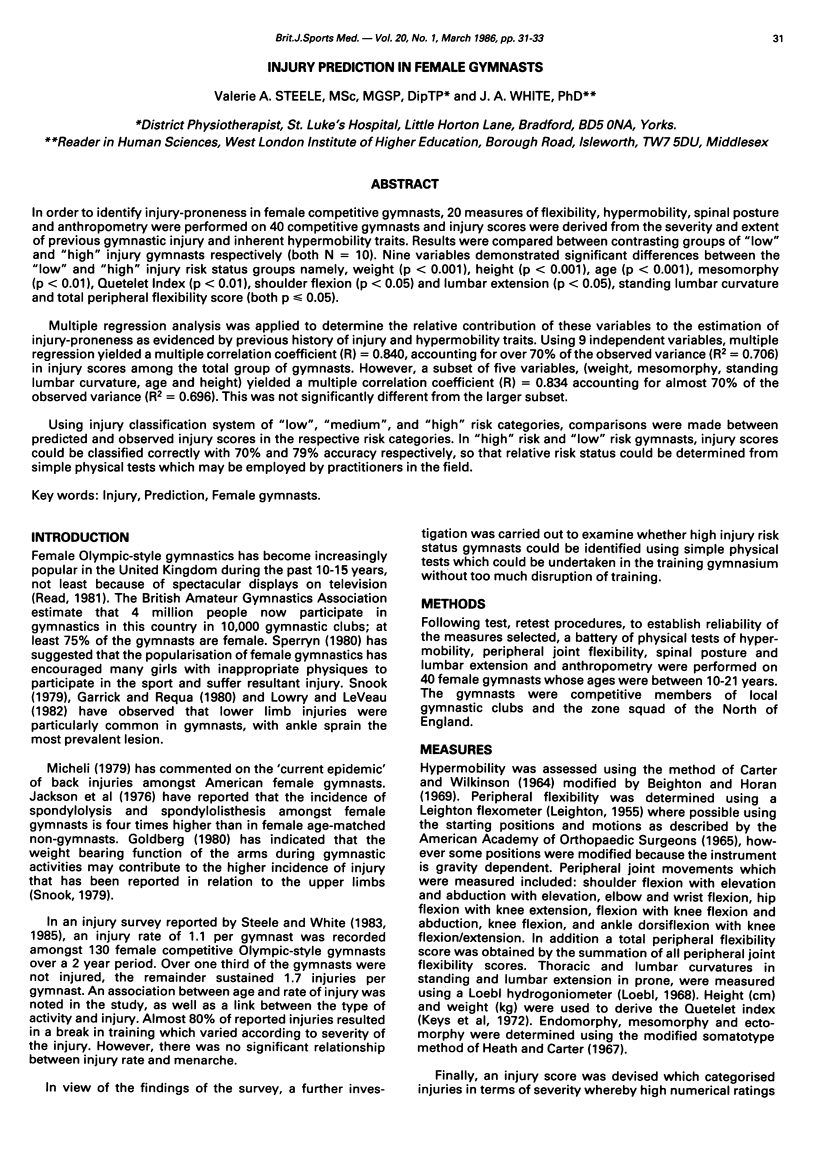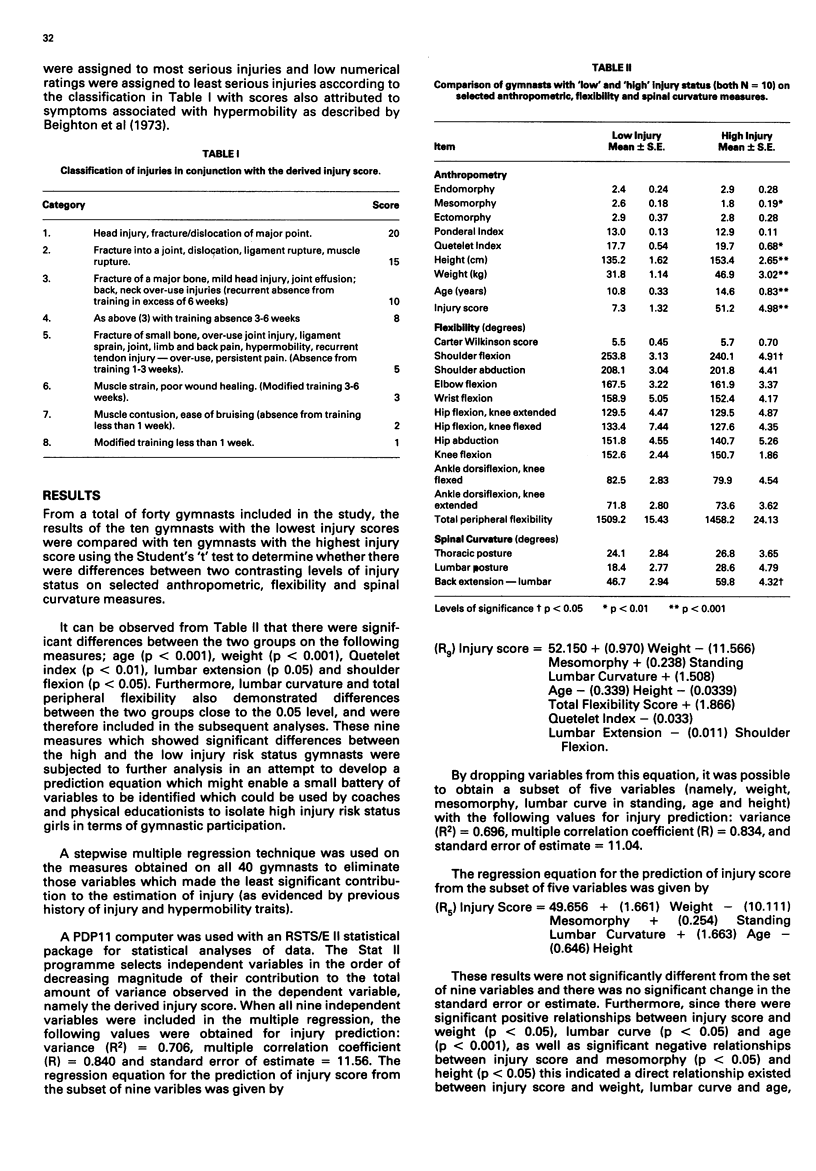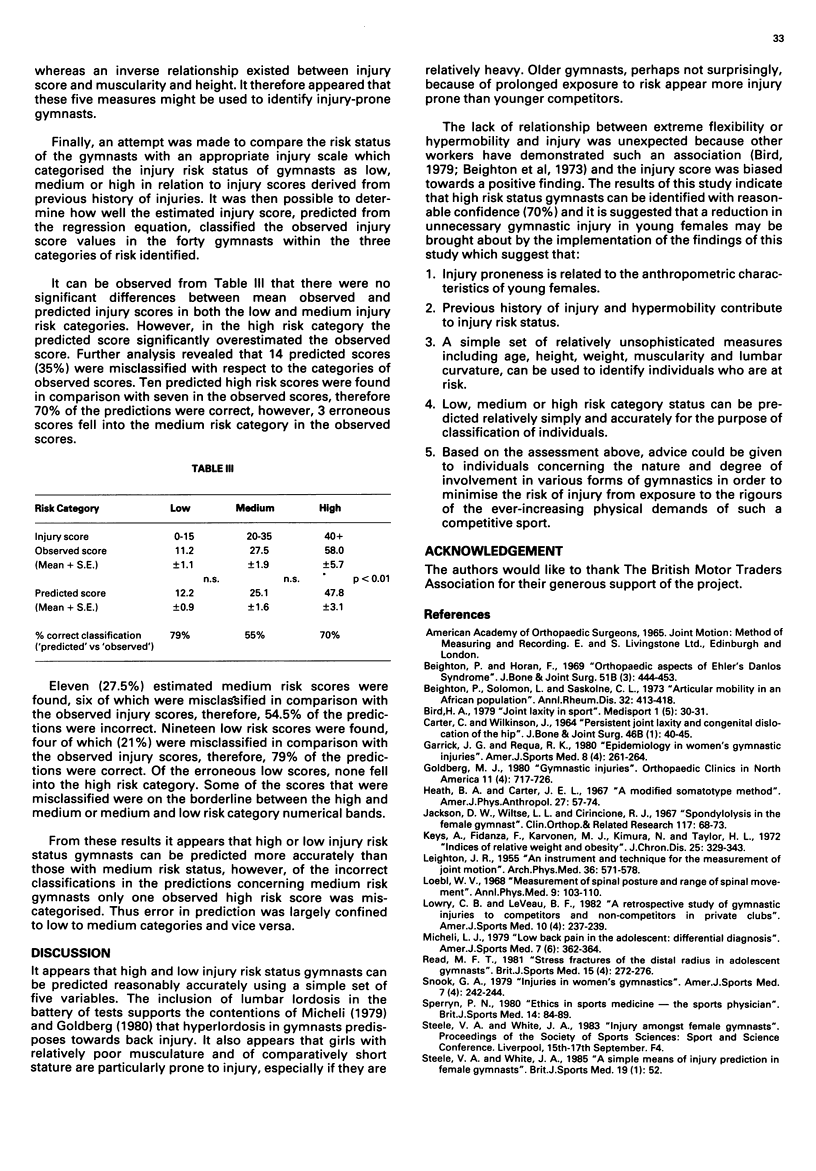Abstract
In order to identify injury-proneness in female competitive gymnasts, 20 measures of flexibility, hypermobility, spinal posture and anthropometry were performed on 40 competitive gymnasts and injury scores were derived from the severity and extent of previous gymnastic injury and inherent hypermobility traits. Results were compared between contrasting groups of "low" and "high" injury gymnasts respectively (both N = 10). Nine variables demonstrated significant differences between the "low" and "high" injury risk status groups namely, weight (p less than 0.001), height (p less than 0.001), age (p less than 0.001), mesomorphy (p less than 0.01), Quetelet Index (p less than 0.01), shoulder flexion (p less than 0.05) and lumbar extension (p less than 0.05), standing lumbar curvature and total peripheral flexibility score (both p less than or equal to 0.05). Multiple regression analysis was applied to determine the relative contribution of these variables to the estimation of injury-proneness as evidenced by previous history of injury and hypermobility traits. Using 9 independent variables, multiple regression yielded a multiple correlation coefficient (R) = 0.840, accounting for over 70% of the observed variance (R2 = 0.706) in injury scores among the total group of gymnasts. However, a subset of five variables, (weight, mesomorphy, standing lumbar curvature, age and height) yielded a multiple correlation coefficient (R) = 0.834 accounting for almost 70% of the observed variance (R2 = 0.696). This was not significantly different from the larger subset. Using injury classification system of "low", "medium", and "high" risk categories, comparisons were made between predicted and observed injury scores in the respective risk categories. In "high" risk and "low" risk gymnasts, injury scores could be classified correctly with 70% and 79% accuracy respectively, so that relative risk status could be determined from simple physical tests which may be employed by practitioners in the field.
Full text
PDF


Selected References
These references are in PubMed. This may not be the complete list of references from this article.
- Beighton P., Horan F. Orthopaedic aspects of the Ehlers-Danlos syndrome. J Bone Joint Surg Br. 1969 Aug;51(3):444–453. [PubMed] [Google Scholar]
- Beighton P., Solomon L., Soskolne C. L. Articular mobility in an African population. Ann Rheum Dis. 1973 Sep;32(5):413–418. doi: 10.1136/ard.32.5.413. [DOI] [PMC free article] [PubMed] [Google Scholar]
- CARTER C., WILKINSON J. PERSISTENT JOINT LAXITY AND CONGENITAL DISLOCATION OF THE HIP. J Bone Joint Surg Br. 1964 Feb;46:40–45. [PubMed] [Google Scholar]
- Garrick J. G., Requa R. K. Epidemiology of women's gymnastics injuries. Am J Sports Med. 1980 Jul-Aug;8(4):261–264. doi: 10.1177/036354658000800409. [DOI] [PubMed] [Google Scholar]
- Goldberg M. J. Gymnastic injuries. Orthop Clin North Am. 1980 Oct;11(4):717–726. [PubMed] [Google Scholar]
- Heath B. H., Carter J. E. A modified somatotype method. Am J Phys Anthropol. 1967 Jul;27(1):57–74. doi: 10.1002/ajpa.1330270108. [DOI] [PubMed] [Google Scholar]
- Keys A., Fidanza F., Karvonen M. J., Kimura N., Taylor H. L. Indices of relative weight and obesity. J Chronic Dis. 1972 Jul 1;25(6):329–343. doi: 10.1016/0021-9681(72)90027-6. [DOI] [PubMed] [Google Scholar]
- LEIGHTON J. R. An instrument and technic for the measurement of range of joint motion. Arch Phys Med Rehabil. 1955 Sep;36(9):571–578. [PubMed] [Google Scholar]
- Loebl W. Y. Measurement of spinal posture and range of spinal movement. Ann Phys Med. 1967 Aug;9(3):103–110. doi: 10.1093/rheumatology/9.3.103. [DOI] [PubMed] [Google Scholar]
- Lowry C. B., Leveau B. F. A retrospective study of gymnastics injuries to competitors and noncompetitors in private clubs. Am J Sports Med. 1982 Jul-Aug;10(4):237–239. doi: 10.1177/036354658201000409. [DOI] [PubMed] [Google Scholar]
- Micheli L. J. Low back pain in the adolescent: differential diagnosis. Am J Sports Med. 1979 Nov-Dec;7(6):362–364. doi: 10.1177/036354657900700613. [DOI] [PubMed] [Google Scholar]
- Read M. T. Stress fractures of the distal radius in adolescent gymnasts. Br J Sports Med. 1981 Dec;15(4):272–276. doi: 10.1136/bjsm.15.4.272. [DOI] [PMC free article] [PubMed] [Google Scholar]
- Snook G. A. Injuries in women's gymnastics. A 5-year study. Am J Sports Med. 1979 Jul-Aug;7(4):242–244. doi: 10.1177/036354657900700407. [DOI] [PubMed] [Google Scholar]
- Sperryn P. N. Ethics in sports medicine--the sports physician. Br J Sports Med. 1980 Jul;14(2-3):84–89. doi: 10.1136/bjsm.14.2-3.84. [DOI] [PMC free article] [PubMed] [Google Scholar]


